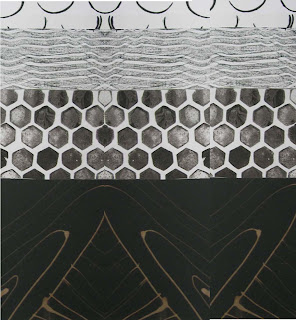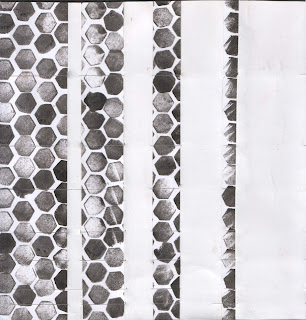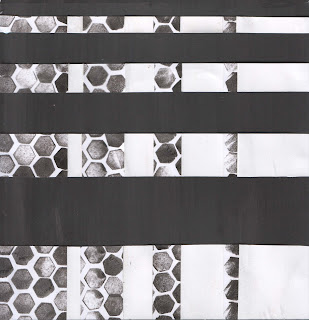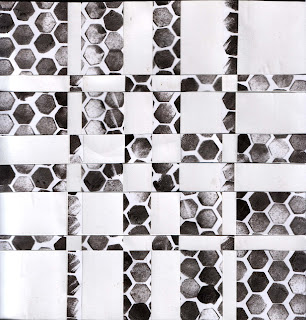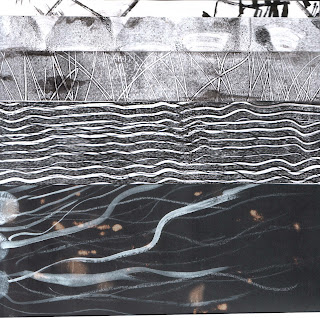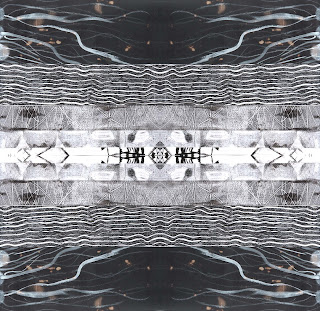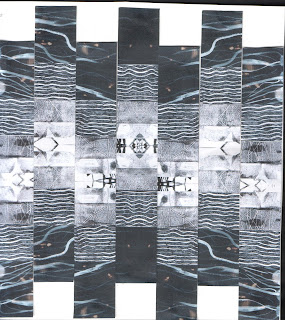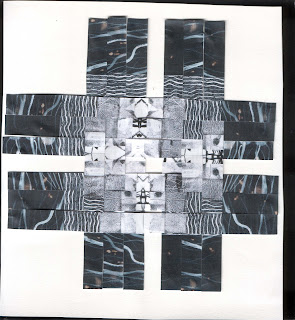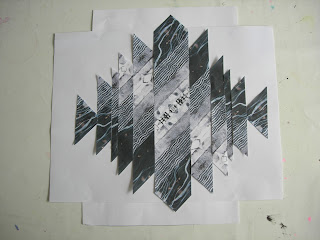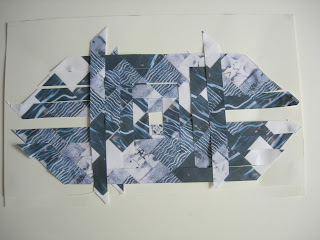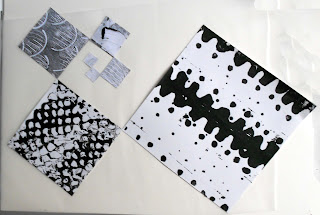"Not What It Seams"
In this chapter we were continuing with piecing our patterned fabrics, but finding ways of making the seams more interesting.
I started by making a Seminole sample, cutting some strips diagonally and others straight across. This gave a series of wavy lines crossing the piece. A spotted fabric for one line produced the "wiggly lines and circles" that I found interesting in my original drawing from animal markings. To make the seams more interesting, I lapped the seams and then frayed them to make fringes. I liked how this gave a smooth but still raggedy look. See sample 2.8S.1.
 |
2.8S.1
|
Next I had fun making a sample with every different effect I could think of. See sample 2.8S.2.
 |
2.8S.2
|
Below are some details of sample 2.8S.2. The top seam is a channel seam in which the seam is open to show a contrast fabric below (I found the instructions in an old sewing book). I caught the loose edges back with a stitch or two every 6cm or so and stitched the loose edges together in between. The contrast fabric underneath is one of my less succesful machine stitched strips from chapter 3. See detail A.
 |
Detail A of 2.8S.2
|
The next seam was a plain one, but decorated by hand-stitching some French Knitting (or what we as children called "catty's tails") in a wiggly line. See detail B.
 |
| Detail B of 2.8S.2 |
In the third seam, I trapped squares of patterned fabric by pinching the centre point and trapping it in the seam, giving a series of handkerchief points. The fourth seam is lapped and fringed, stitched with a decorative stitch. Seam 5 is a French seam, padded with wool and tied at regular intervals with narrow black ribbon. Seam 6 is a normal seam, but decorated with metal washers hand stitched at the edge. All of these can be seen in detail C.
 |
| Detail C of 2.8S.2 |
For the seventh seam, I folded squares of fabric in two with the crease at the top, folded down each top corner to the bottom centre and pressed them, before trapping them in the seam to give triangular points. See detail D.
 |
| Detail D of 2.8S.2 |
Finally, I trapped knotted narrow strips of fabric in the seam. See detail E.
 |
Detail E of 2.8S.2
|
Trimmings
We were asked to make some simple ideas we could use to trim our functional 3D item (which we'll be making in a later chapter). These were ribbons, cords and toggles.
Ribbons
The first ribbon I made was a pieces strip left over from some Seminole work. I tried various machine stitches, varying the length of the stitch to give different intensities of stitch.
 |
2.8R.1
|
However, I found this a bit boring so decided to try to embellish it. I cut some fabric squares and ran a gathering stitch up the centre. When gathered, they gave bow tie shapes which I then stitched onto the strip at intervals. Finally, a variety of black and white buttons to decorate each bow tie. See 2.8R.2.
 |
2.8R.2
|
Next, I tried laying several strips of varying widths on top of each other. Again, trying to interpret my wiggly lines and circles, I chose fabrics with patterns of wiggly lines and added wiggly stitch on top. Buttons and washers hand-stitched on gave the circles. See 2.8R.3.
 |
2.8R.3
|
I had been left with lots of scraps and strips of fabrics, so I knotted some of these together to make another ribbon. I rather liked the raggedy quality of this. See 2.8R.4.
 |
2.8R.4
|
Cords
 |
| 2.8C.1 |
From left to right, the techniques used are:
- a simple fabric strip, knotted at intervals
- a bunch of several fabric strips twisted together and knotted
- a single strip of fabric, twisted and machine zig-zagged to secure. I used a bought spotted fabric for this and I liked how the occasional black spot shows through the stitching.
- three twisted fabric strips plaited with the ends knotted to secure
- a fabric strip twisted and then machine zig-zagged to secure
- three strips twisted and stitched as in 5 above, then plaited together
Toggles
 |
2.8T.1
|
From left to right the techniques used are:
- a simple strip of fabric rolled up and stitched to secure.
- a strip of fabric folded and knotted
- three strips of different fabrics laid one on top of the other, folded and knotted
- a strip of fabric knotted four times one on top of the other
- a "monkey's fist knot" tied in an extra long strip of fabric
Finally, while chopping leeks, inspiration struck with an idea for a tassel. See 2.8T2.
 |
leeks
|
 |
2.8T.2
|
I have really enjoyed this chapter - a little light relief - and look forward to using the various trimmings in my final 3D piece.
